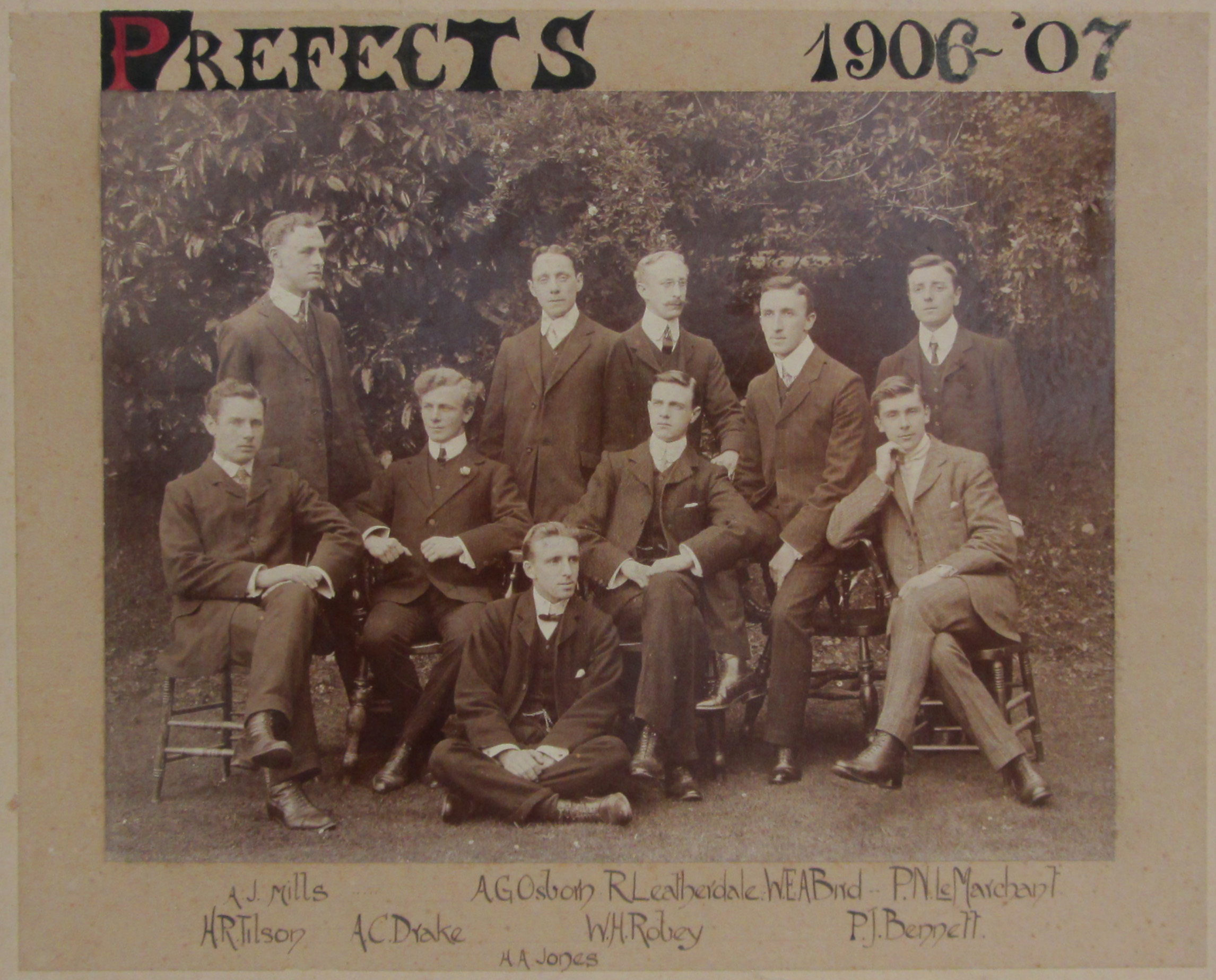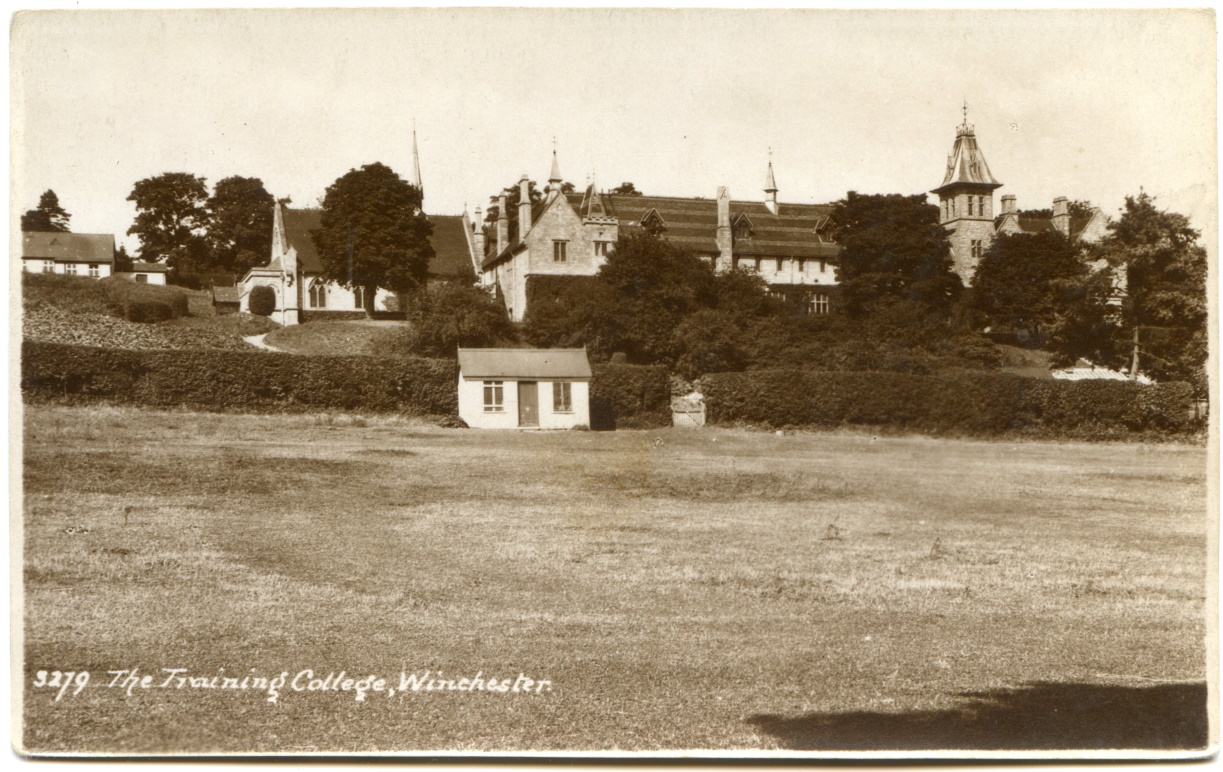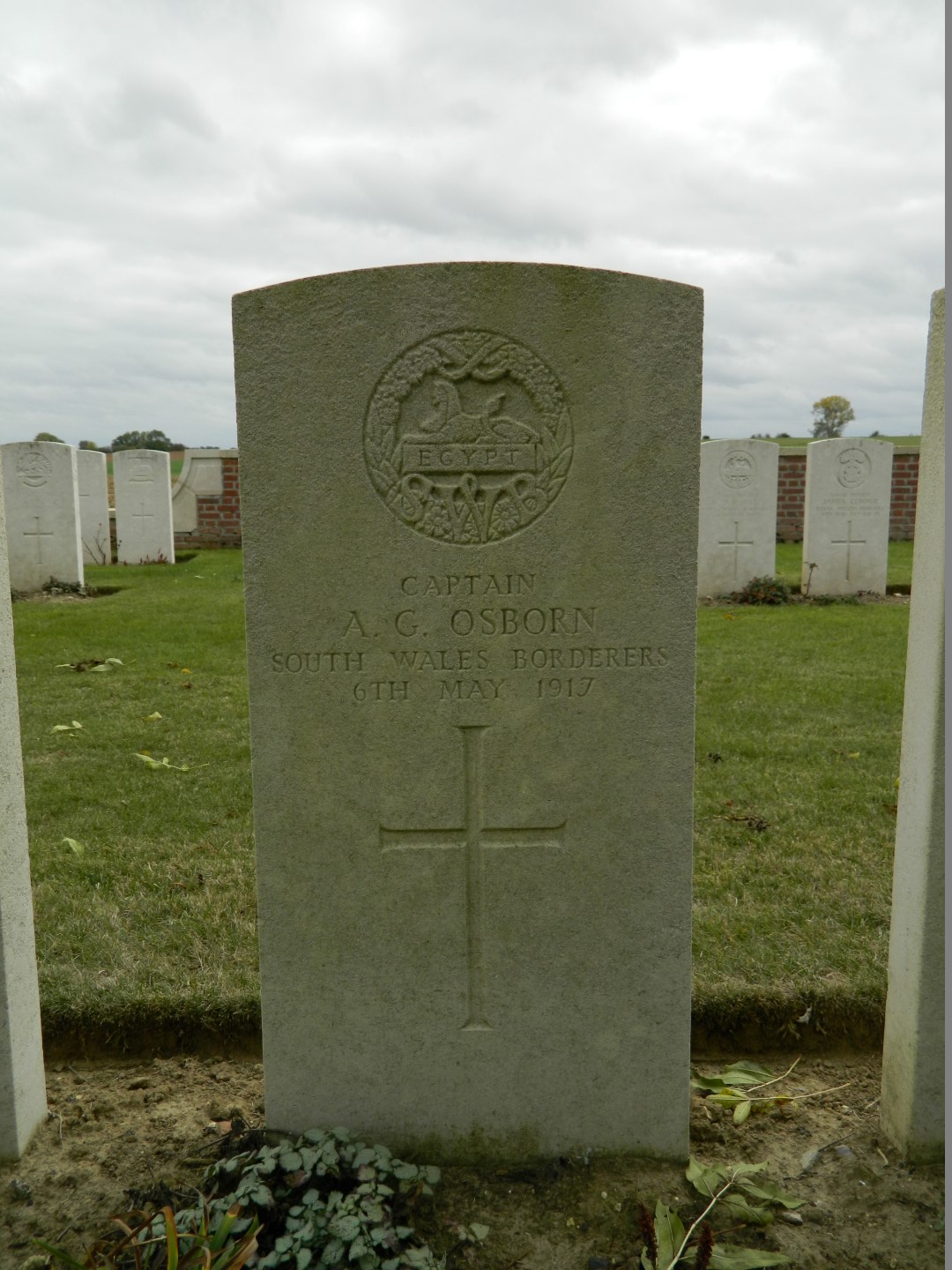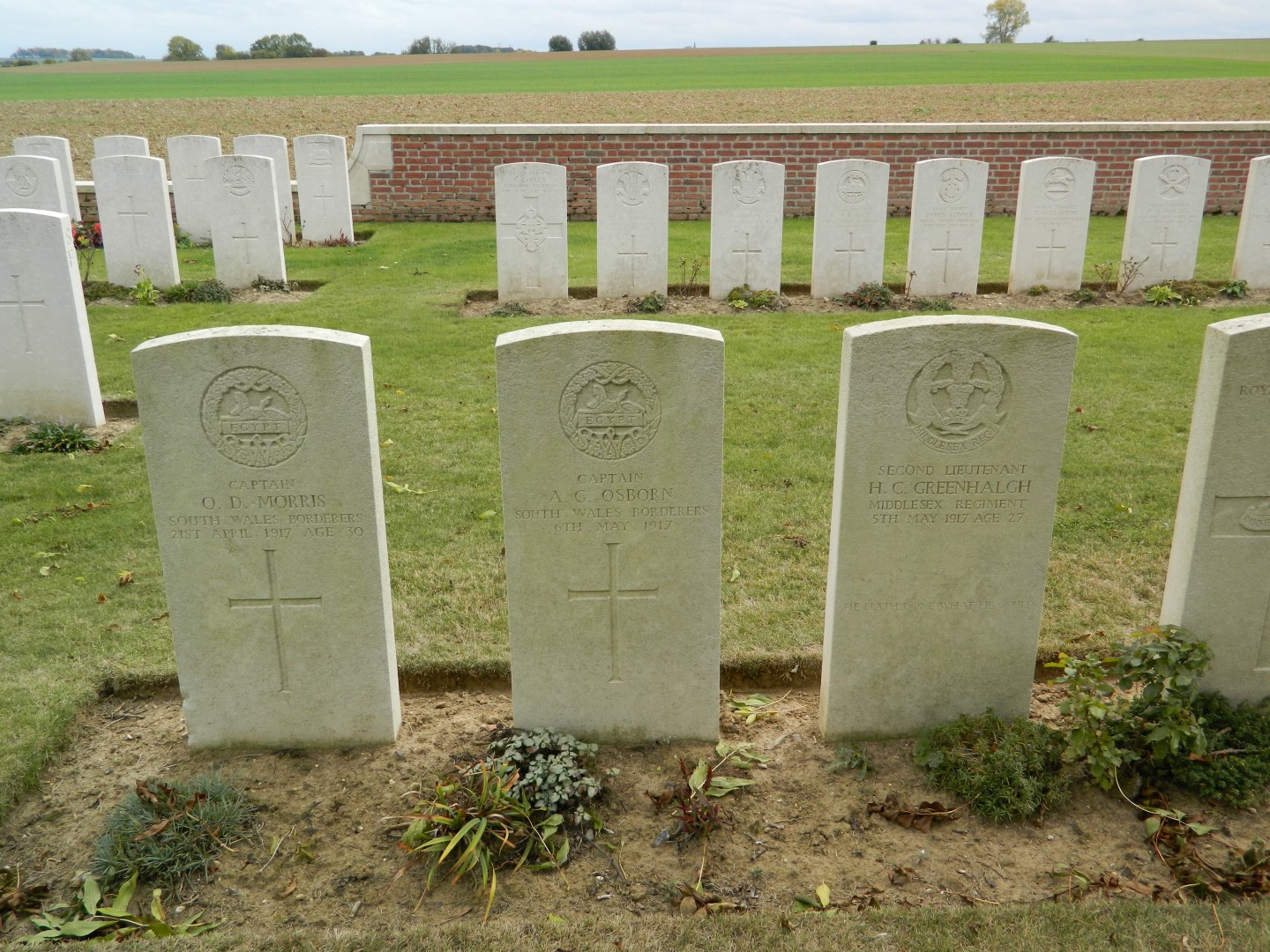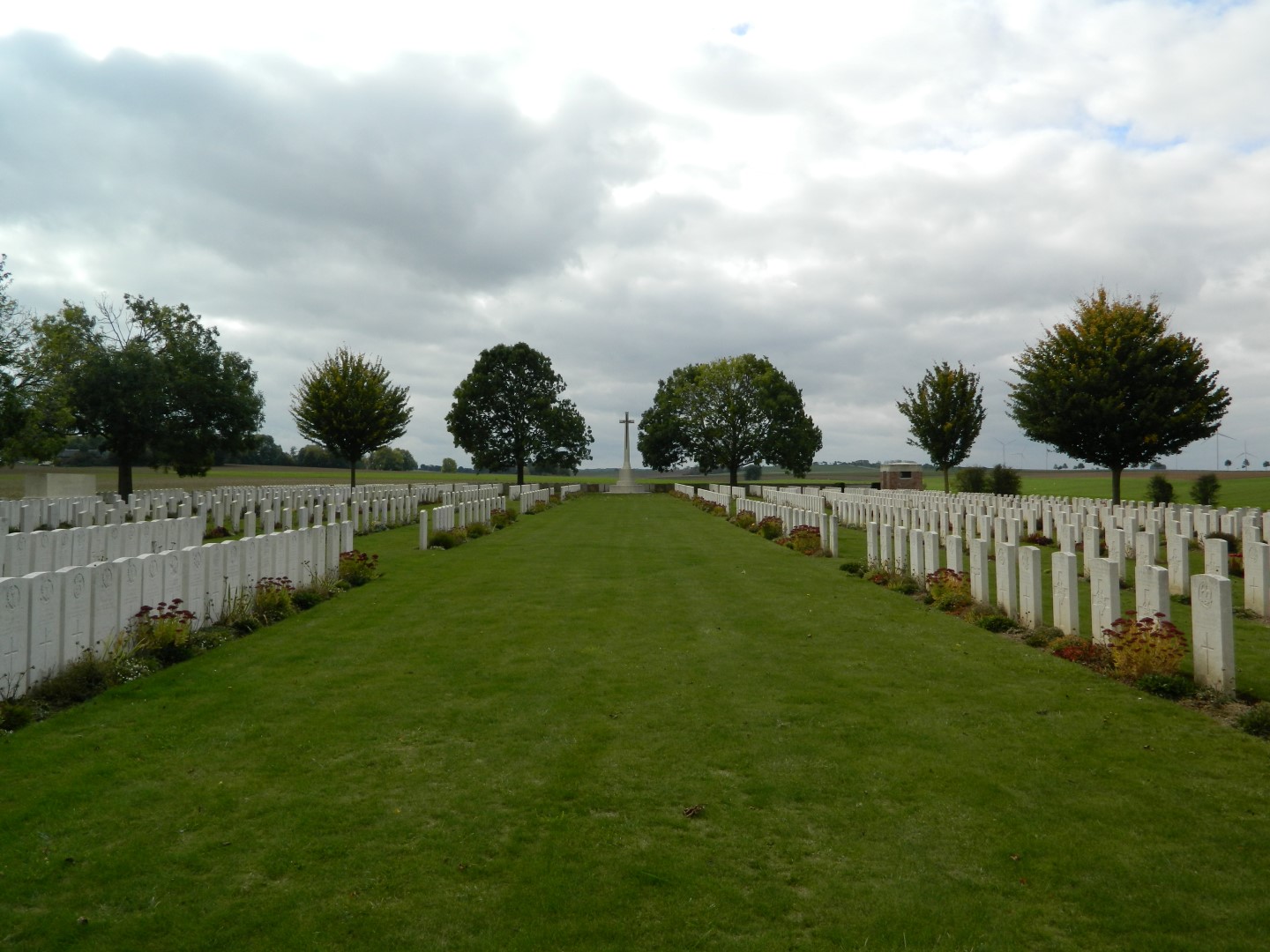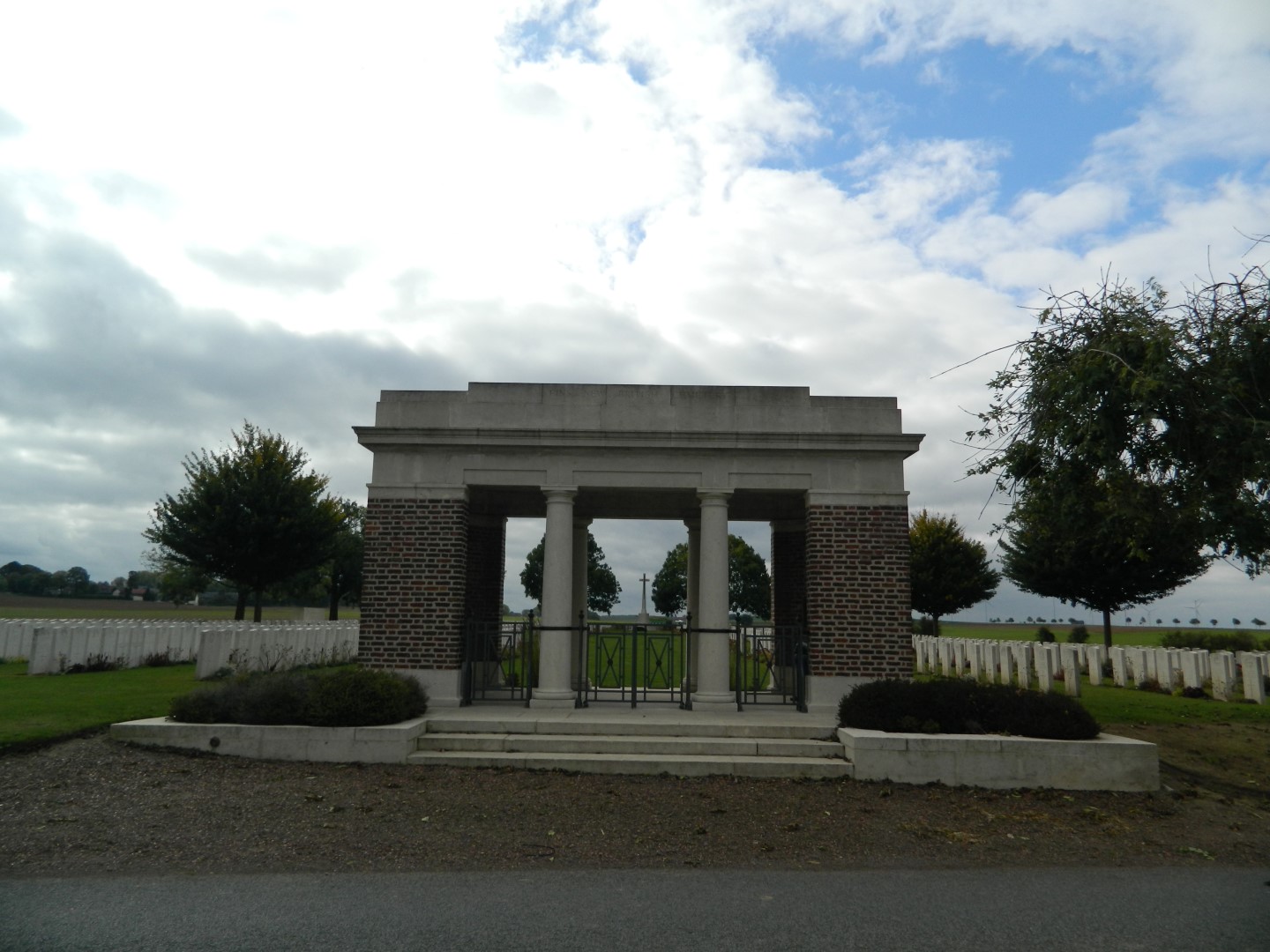Arthur Guy Osborn
Captain Arthur Guy Osborn of the 12th Battalion, South Wales Borderers, was killed in action at La Vacquerie, France, on 6th May 1917, aged 32, and is buried at Fins New British Cemetery, Sorel-Le-Grand, in France.
Early Life
Arthur at College, photograph taken from a group of Student Officials 1906-7
Arthur was born on 5th November 1884 in Wandsworth, London. The 1891 census tells us that his father, Samuel James,1 had a drapery business in Clapham. It must have been thriving as he employed five draper’s assistants and an apprentice. They also had sufficient funds to employ a servant and a nurse. It is possible that the nurse was employed to assist with Samuel’s brother, Alfred, who lived with them and was described as being an imbecile from birth. The linen drapery business had belonged to Arthur’s grandparents, and had been located at the same address as far back as 1861. The 1851 census shows them running a drapery business in Reading, Berkshire.
We know from the Electoral Register that Samuel was still living in Clapham in 1894. By the 1901 census the family resided at Kinson Lodge, Uppleby Road, Branksome, East Dorset. An article in the Bournemouth Guardian mentions Arthur at school in 1895, which dates the move away from London, and a change of career for Samuel, sometime around 1894/5. Uppleby Road still exists today, although Kinson Lodge sadly does not. Head of the household was Samuel, aged 46, and now described as a market gardener, living with his wife Georgina (née Hart, aged 41). There were also three children, the eldest of whom was Arthur, then aged 16, his brother Charles Ernest (12) and sister Dorothy Evelyn (9). Samuel’s younger brother Alfred was still living with them and working in the market garden business. Georgina’s mother Caroline also lived with them. The Census tells us that Arthur was working as a school teacher. Once Arthur had decided on a career in teaching he served an apprenticeship working as a pupil-teacher at his elementary school, St. Peter’s Boys’ School in Parkstone, Dorset, until 1904.2 He then became an assistant teacher at Heatherlands Boys’ School in Bournemouth. As we know that he began his course at College in 1905, his appointment at Heatherlands must only have lasted for a year.
Newspaper reports tell us that Arthur had done well at school. An article in the Bournemouth Guardian (dated 7/9/1895) tells us that ‘The following children attending the St. Peter’s Schools have obtained a sufficient number of marks to qualify them for prizes for religious knowledge in the last May examinations: …Arthur Osborn… The papers sent in from the lower standards show careful and intelligent teaching. Arthur Osborn and William Wareham doing the best and Arthur Osborn and George Saunders were among the best in Prayer Book and Catechism.’ Seven years later another report, this time in the Bournemouth Daily Echo (dated 7/8/1902) tells us that ‘The results of the examinations held in this diocese for assistant and pupil-teacher candidates has just been made known. The names in the first class (senior group) include Arthur G Osborn (230 marks).’
The 1911 census included a question asking the mother of the family how many live children she had given birth to, and how many were still alive. Georgina recorded that five live children had been born to her, but that only three were still living. Winifred Mary E Osborn had been born in 1886, but she died in 1894 aged 8. The fifth child was James Samuel, born in 1882 and died in 1884 aged 2.3
By the 1911 Census Arthur had left the family home and was boarding at 5, Beaumont Place in Bournville, Birmingham, where he was a certificated assistant schoolmaster in King’s Norton Church School. He was boarding in the house of William Lupton Bunning, a Grocer’s Warehouseman. The Osborn family home was still in Dorset, but Dorothy was the only child still living at home. Caroline, the mother in law, had passed away and Samuel’s brother Alfred was 50 years old and still working with his brother in the market garden business. The 1911 census records that Alfred was ‘feeble-minded’, and we have to assume that Samuel had taken responsibility for looking after his younger brother. To supplement their income the family had taken in two boarders both from Essex, one of whom was 12. Charles, Arthur’s brother, had left home and was boarding in the house of Albert Maynard, a cabinet maker, in Worthing, Sussex. Charles was working as an assistant of the Customs and Excise branch of the Civil Service.
Winchester Training College
Arthur attended Winchester Training College from 1905 to 1907. The Bournemouth Daily Echo from Thursday 10th August 1905 reports; ‘An assistant master, Mr A.G.Osborne (sic), on leaving for Winchester Training College, was made the recipient of a fountain pen.’ In all the entrance examinations he took for entry to College, Arthur was awarded first Class passes. Whilst at Winchester he would have become a part of B Company of the Hampshire Rifle Volunteer Corps, training which would have stood him in good stead for what was to come a few years later. His attestation record states that he spent three years in 1st Hants Battalion, which was not the usual College Battalion. It is possible that this was just a simple mistake made on filling out the form. We know a little of his interests while at College, from the College student magazine, The Wintonian. In the first social event of his Junior Year, A Smoking Concert held in the Common Room, it was reported that Arthur contributed, sadly it does not tell us what form his contribution took, perhaps he sang, played an instrument or recited poetry. He represented the College Cricket team in his Junior year and was part of the Inter-College Arcadians football team. Another of the social activities that the students participated in was debating. The Wintonian reports that in the debate Is Socialism a Remedy for Social Evils? Arthur opened in support of Socialism. We also have a record of his academic results. In the first year examinations he achieved an average mark of 83.5% which placed him second in the year group order of merit. He was awarded a First Class pass in his final Board of Education Certificate exams, with distinctions in music and teaching.
From the archive held at The Hampshire Record Office
The War
After war had been declared Arthur enlisted on 14th September 1914 , as a Private in the Royal Warwickshire Regiment, number 955, attesting in Birmingham. He was described as 5ft 8 ½ in tall, weighing 138 lbs. with a 36 ½ in chest, and a chest expansion of 4in. Arthur had a fresh complexion with grey eyes and brown hair. He was quickly promoted to Corporal and by 17th February 1915 had become Sergeant. His time training for war with the Royal Warwickshire Regiment was described in a letter written by Arthur.
The enthusiasm, the hilarity, and the determination after week’s ‘gruelling’ have been well maintained, and there has already sprung into existence a factor which will make even more than these towards the success of the Birmingham Boys’ as soldiers of the King. This factor is the sense of comradeship between fellows in the same squad or same company, —the esprit de corps which makes ‘D’ company or No. 23 Squad, THE BEST—indeed the ONE AND ONLY for the men in it. It leads to the most healthy desire to make one’s squad or one’s company excel, and leads to the passing round of the word ‘smarten up boys!’ when, after more than three hours’ hard drill, The return to the parade ground is made.
This week we have had parades daily:
- from 7 am to 7:50 am for physical exercises (many of which are stiff)
- from 9:30 am to 12:45 pm
- from 2:00 pm to 4:45 pm
The second and third parades are devoted to squad drill, but so rapid has been the progress that all squads have already had considerable practice in extended order drill (skirmishing) while the BEST company, D Company, in which the majority of the teachers (including myself) are enrolled, has actually had two practices in company drill. D company is fortunate in having the most splendidly efficient Sergeant-Major in Sergeant-Major Phillips (CSM J W Phillips No. 1084), who was perhaps the best officer in the whole battalion. With regards to myself, I am glad to say that I am standing the hard grind jolly well. My heart is in this business, and though I am not yet free from aches, I am beginning to feel most fit. Apparently I am doing well. On Thursday I was called out with others to give a few commands to the fellows in my squad, i.e. 20 fellows, for the whole of the first parade. In a week or so I am taking the Corporal’s examination, so I may soon be 955 Cpl A G Osborn (I say I may). I am billeted with three chums: Jack Reeves (No. 971, from Beaumont Road, Bournville), Wilfred Ward (from Featherstone Road, Kings Heath), and Arthur Bacon (No. 852, from Birchwood Crescent, Moseley). Bacon is a singer of sentimental and comic songs and he’s a real humourist at times. We all find ourselves very jolly and comfortable together, and spare time passes only too quickly. Our hosts are doing us well. Mr C Jones, in whose house we are living, said to his wife: ‘The lads are doing their best for their country; let us do our best for them.’ And they are doing it right down well.
So far we are without uniforms, but we are proud of the badge we all have to wear.
Arthur’s story then becomes rather puzzling. Records show that on 10th July 1915 he both filled out the application to apply for a commission and reverted to the rank of Private at his own request. We have not yet discovered if this was an unusual course to take or fairly standard practice. As far as we have been able to ascertain it was not required under King’s Regulations. Currently there is no evidence to show why he was drawn to the South Wales Borderers, but this was the Regiment he requested on his application for commissioning. He was commissioned as a temporary Second Lieutenant into the 12th Battalion SWB on 19th July 1915 and this was published in the London Gazette in August 1915. Arthur arrived at his new regiment months after its formation in March 1915. This Battalion was reported as a Bantam unit,4 and was for those who were of mixed regulation height and shorter men.
In September 1915 they were moved to Aldershot, where the formation was renamed as 119th Brigade, 40th Division. There was an extended period of time before the 40th Division saw action. Between September and December 1915 there was a weeding out of very under-sized and unfit men, delaying the training programme, and it was not until the spring of 1916 that they were considered ready for active service.
Before the battalion was sent into action there was a special day in Arthur’s life as he married Frances Elizabeth Hall on the 14th March 1916. She was listed as a professional singer born in Swansea and residing in Chingford, Essex with her mother and father and eight siblings. The census returns show that the family moved around a great deal as the siblings were all born in different parts of the UK. This could be related to her father’s occupation as a superintendent of grain cargoes. Frances lived to be 98 when she died in Droitwitch. She had remarried in 1929.
The War Diary shows the movements of the 40th Division from when it landed at Le Havre between 2nd and 6th June 1916 and by 9th June it had concentrated near Lillers 5 It then served between June and late October 1916 on the front near Loos.
The 40th Division was involved in a number of actions in France until its disbandment in 1918, the first being the Ancre which was part of the Somme Offensive. In 1917 it was involved in the German retreat to the Hindenburg Line and the capture of Fifteen Ravine, Villiers Plouich, Beaucamp and La Vacquerie.
1917 saw many actions that became increasingly desperate. The War Diary for the South Wales Borderers tells of increased night actions and the need to capture prisoners as intelligence was seen to be paramount to success. The German retreat to the Hindenburg line signalled this growing need for action, and the engagements beginning at Fifteen Ravine heralded the start of a series of actions that would eventually see the death of Arthur.
‘Fifteen Ravine’ was the name given by the Army to the shallow ravine, once bordered by fifteen trees, which ran at right angles to the railway about 800 metres south of the village of Villers-Plouich…
Quote from the Commonwealth War Graves Commission
The Trench map (courtesy of the National Library of Scotland, Sheet 57C SE) shows the trenches corrected to May 1917 and includes the villages of Beaucamps, Villiers Plouich, and La Vacquerie. South of Villiers lies Fifteen Ravine which can be seen running diagonally across square 19. The map was made on 11th May 1917, just one week after Arthur’s death. It also documents the Hindenburg Line defences, in red, running from square 9 to 23. The solid lines are trenches and the dotted lines the wire entanglements.
The War Diary documents Arthur’s part in the events leading up to the attack on Fifteen Ravine:
18th April — The day was quiet and all men were employed in improving their accommodation and wiring the line. In the evening Lt A.G Osborn took out a fighting patrol to investigate FIFTEEN RAVINE and found it strongly held.
19th April — As for yesterday, Lt. Osborn took out another strong patrol and reconnoitred the line. Lt W.J. Williams carried out a daylight reconnaissance of Q24 and discovered a series of hostile snipers in the neighbourhood of TRESCAULT. Sniping was continuous all day. Instructions were received today that the Battalion would take part in the next operation on advance on the HINDENBURG LINE their duty being the capture and consolidation of FIFTEEN RAVINEA and B Coys were detailed for the assaulting line and C and D as supports.
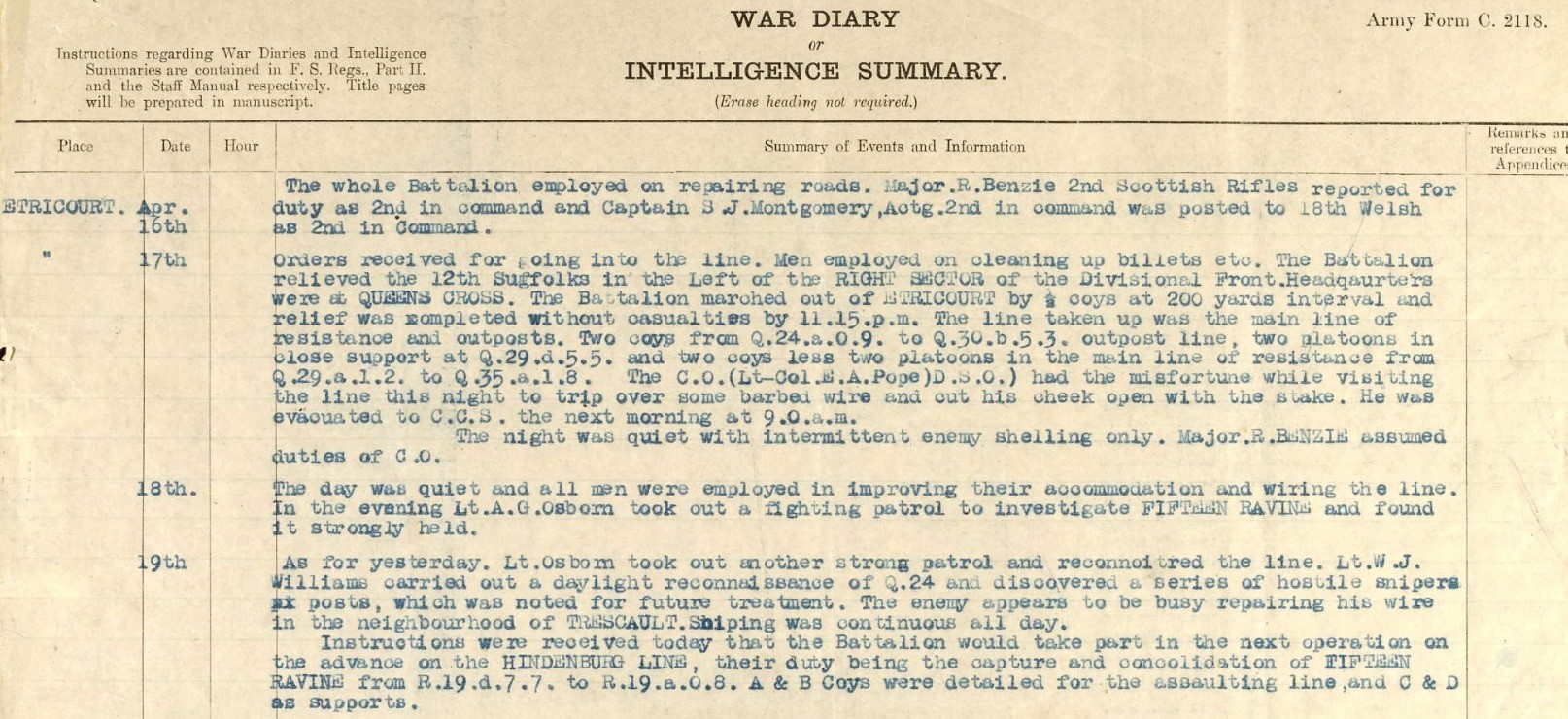
The South Wales Borderers War Diary, gives an example of the actions taking place, which included Capt. Arthur Osborn. (See above for transcription)
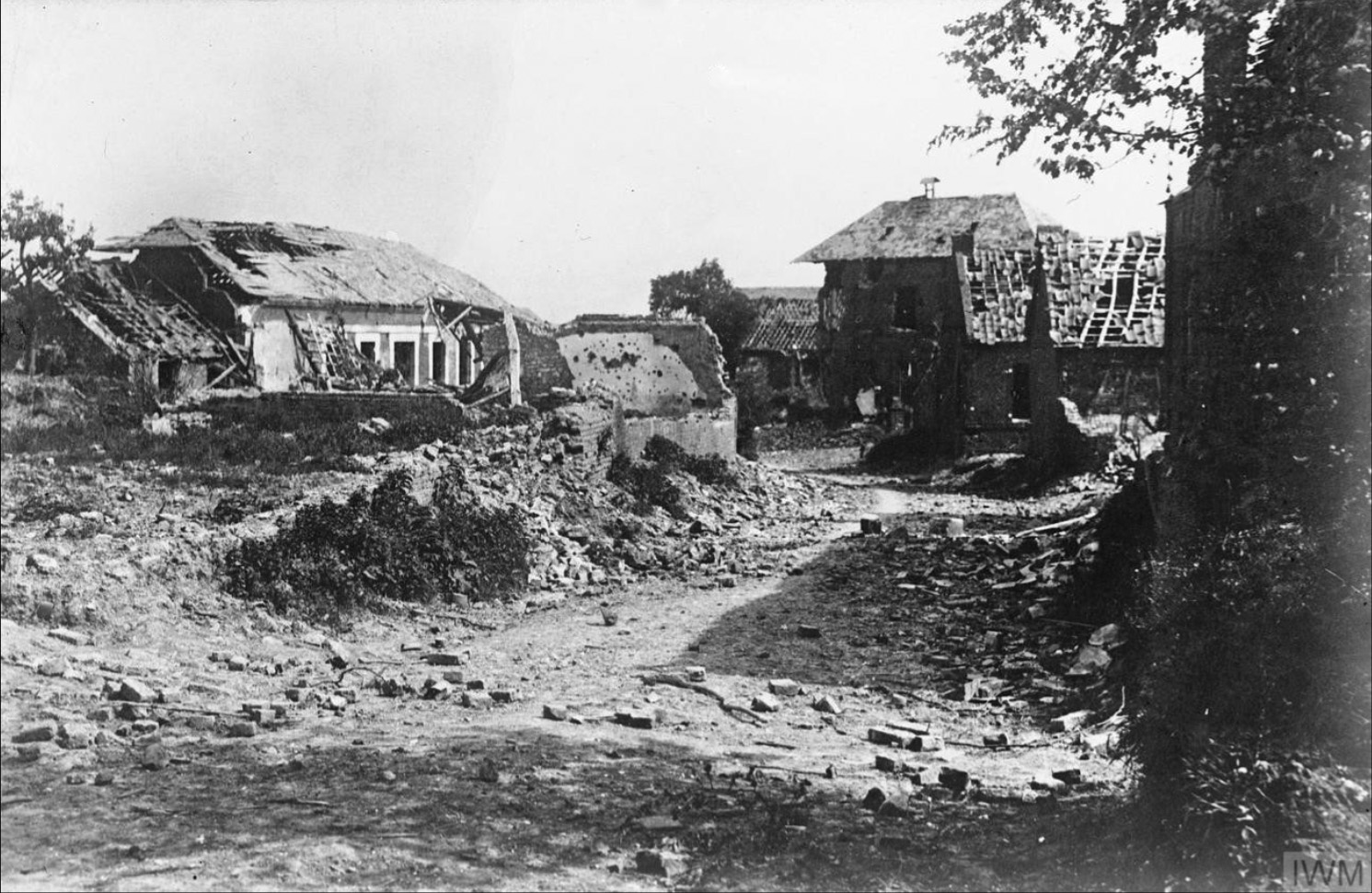
The remains of the village of La Vacquerie. Copyright IWM Q45639
The 12th Battalion of the South Wales Borderers remained in the area. In the time between the attack on Fifteen Ravine in April and the action at La Vacquerie, Arthur was promoted to Temporary Captain on the 22nd April 1917, gazetted posthumously on 31st May 1917. The village of La Vacquerie was on the German defensive Hindenburg Line. By the end of April most of the villages west of the Hindenburg Line had been captured. The small village of La Vacquerie was the next target. This was part of a larger operation along a large stretch of the Hindenburg Line, in which the capture of La Vacquerie was planned to take place ten days earlier than the main attack. The War Diary gives us a picture of the preparations for the planned assault on La Vacquerie.
1st May 1917 — our artillery have been very busy all day wire cutting around and about the village. Enemy very quiet. There was much aerial activity during the day. At night the Bosch is still up to his old tricks of burning and destroying property. NO MAN’S LAND has been carefully patrolled by us and we are given a clear field. No sign of hostile patrols out.
2nd — We are having glorious weather. Wire cutting continues. Nothing much doing otherwise except spasmodic bursts by the Bosch artillery.
3nd — Quite appreciable gaps seen in hostile wire today. The enemy seem to be very nervous of an attack. During the night he kept sending up single Very Lights which were followed by a bombardment of No Man’s Land. Our patrols again out, but encountered nothing.
4th — There was a test barrage made by our artillery on the enemy’s lines at 4.5 a.m. this morning in order to find out how soon and where would the enemy’s reply barrage fall. His reply was feeble, but our ruse served the purpose it was intended for. Our artillery still active on the wire. Patrols still busy. One patrol under Battalion Intelligence Officer reconnoitres Cemetery west of village, but found emplacements and pits were manned, but before returning managed to scatter occupants and destroy rifle pits on N.W. side of village taking one prisoner.
5th — Orders were received from Brigade in regard to operations on La Vacquerie Front Line (Right) 12th Bn S.W. Borderers. The assaulting waves were to push on till their objectives were reached, and then hold on as a covering party till 1.0a.m.. The support were to form a second line in rear.
The War Diary gives no details of the action that followed, nor does it give the names of casualties. The entry for the 6th May, the day that Arthur died, simply states, ’Dispositions of May 6th were altered B & D Companies went into the front line, C Coy in Support. The day was quiet, we sent out a strong patrol at dusk to bring in the few dead we found the evening before, but found the area raided the night before re-occupied by the enemy but were able to bring back two of the dead. At 10 p.m. the Battalion was relieved by the 18th Bn Welsh Regt.’
On the night of the 5th May 1916, a raid by the 8th and 40th Divisions succeeded in capturing the village. Under heavy artillery fire, and sustaining huge losses, they could only hold the village for an hour.

German troops repel an attack at La Vacquerie, May 1917. Copyright IWM Q42263
Although the attack on La Vacquerie was launched on the night of the 5th May, Arthur was reported as killed in action on the 6th May 1917. Both the 5th and 6th May are given as the date of his death in official documents in the National Archives, until finally the 6th was accepted as the date for official purposes. Without any further sources of information we can only speculate on the details of Arthur’s death. His body was recovered from the battlefield and he was buried firstly in Fins Churchyard, but later exhumed and reburied at Fins new British Cemetery, Sorel-Le-Grand.
Once the war was over and Arthur’s effect and medals were returned to his wife, probate shows that he left £340 19s 7d. The medal roll card shows his wife living at the family home at 144 Hainault Road, Leytonstone E11.
As a postscript, Arthur was ‘Mentioned in Despatches’ in FM Haig’s Despatch of 7th November 1917, published in London Gazette Issue 30434 dated 14th December 1917.
Arthur is commemorated on the Birmingham Education Committee War Memorial.
Author and Researcher: John Westwood. Revised and additional material by Dee Sayers.
Footnotes
[1] The names Samuel and James were popular in the Osborn family. Arthur’s father was Samuel James, his grandfather was James Samuel and his older brother who died in infancy was James Samuel.
[2] From his College records we know that at some point in his education Arthur attended a Private School in Clapham, Surrey, probably prior to the family relocating to Dorset.
[3] The fifth child was difficult to find as there was another Osborn family living close by in London, where the mother also had the maiden name Hart.
[4] In 1914 the Member of Parliament for Birkenhead, Mr. Alfred Bigland, asked the War office for permission to form a battalion of men who were under regulation height, but otherwise fit for service. A few days later 3,000 men had volunteered, many who had previously been rejected. The first Bantam volunteers were formed into the 1st and 2nd Birkenhead Battalions of the Cheshire Regiment. Other Regiments followed suit with Bantam Battalions being recruited in the Lancashire Fusiliers, West Yorkshires, Royal Scots and Highland Light Infantry. Many of these new recruits were miners. The units were formed into the 35th Another Division, the 40th, had a mixture of Bantam and Regulation units, but it is generally described as a bantam division. By the end of 1916 it was decided that the general fitness and condition of the men volunteering as bantams were no longer up to the standard required, and Brigades were advised that no more undersized men would be accepted.
[5] 40th Division remained on the Western Front until the end of the war.
Sources
Amazing-cambrai.com. (2019). 21. La Vacquerie. [online] Available at: http://www.amazing-cambrai.com/fiche-1257.html [Accessed 25 Apr. 2019].
Ancestry (2018). Home page. [online] Available at: www.ancestry.co.uk [Accessed 2018].
Bournemouth Guardian (1895). [online] p.8. Available at: https://www.britishnewspaperarchive.co.uk/viewer/bl/0002176/18950907/182/0008 [Accessed 25 Apr. 2019].
Bournemouth Daily Echo (1902). [online] p.2. Available at: https://www.britishnewspaperarchive.co.uk/viewer/bl/0000638/19020807/029/0002 [Accessed 25 Apr. 2019].
Bournemouth Daily Echo (1905). [online] p.2. Available at: https://www.britishnewspaperarchive.co.uk/viewer/bl/0000638/19050810/053/0002 [Accessed 25 Apr. 2019].
Carter, T. (2012). Birmingham Pals. Havertown: Pen and Sword.
Commonwealth War Graves Commission, (2018). Home page. [online] Available at www.cwgc.org/ [Accessed 2018].
Discovery.nationalarchives.gov.uk. (2019). Captain Arthur Guy OSBORN. The South Wales Borderers. | The National Archives. [online] Available at: https://discovery.nationalarchives.gov.uk/details/r/C1092135?descriptiontype=Full&ref=WO+339/38236 [Accessed 25 Apr. 2019].
Fr.wikipedia.org. (2019). Bundesarchiv Bild 104-0822, La Vacquerie, deutsche Infantrie.jpg. [online] Available at: https://fr.wikipedia.org/wiki/Fichier:Bundesarchiv_Bild_104-0822,_La_Vacquerie,_deutsche_Infantrie.jpg [Accessed 25 Apr. 2019]
Thegazette.co.uk. (2019). Page 8242 | Supplement 29267, 17 August 1915 | London Gazette | The Gazette. [online] Available at: https://www.thegazette.co.uk/London/issue/29267/supplement/8242 [Accessed 25 Apr. 2019].
Thegazette.co.uk. (2019). Page 13234 | Supplement 30434, 14 December 1917 | London Gazette | The Gazette. [online] Available at: https://www.thegazette.co.uk/London/issue/30434/supplement/13234 [Accessed 25 Apr. 2019].
Rose, M. (1981). A history of King Alfred’s College, Winchester 1840-1980. London: Phillimore.
| University of Winchester Archive “ Hampshire Record Office | ||
| Reference code | Record | |
| 47M91W/ | P2/4 | The Wintonian 1899-1900 |
| 47M91W/ | P2/5 | The Wintonian 1901-1902 |
| 47M91W/ | P2/6 | The Wintonian 1903-1904 |
| 47M91W/ | P2/7 | The Wintonian 1904-1906 |
| 47M91W/ | P2/8 | The Wintonian 1905-1907 |
| 47M91W/ | P2/10 | The Wintonian 1908-1910 |
| 47M91W/ | P2/11 | The Wintonian 1910-1914 |
| 47M91W/ | P2/12 | The Wintonian 1920-1925 |
| 47M91W/ | D1/2 | The Student Register |
| 47M91W/ | S5//5/10 | Photograph of 5 alumni in Mesopotamia |
| 47M91W/ | Q3/6 | A Khaki Diary |
| 47M91W/ | B1/2 | Reports of Training College 1913-1914 |
| 47M91W/ | Q1/5 | Report and Balance Sheets 1904- 1949 |
| 47M91W/ | R2/5 | History of the Volunteers Company 1910 |
| 47M91W/ | L1/2 | College Rules 1920 |
| Hampshire Record Office archive | ||
| 71M88W/6 | List of Prisoners at Kut | |
| 55M81W/PJ1 | Managers’ Minute Book 1876-1903 | |
| All material referenced as 47M91W/ is the copyright of The University of Winchester. Permission to reproduce photographs and other material for this narrative has been agreed by the University and Hampshire Record Office. | ||



